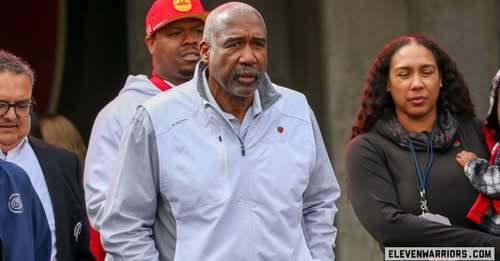**Former Ohio State Athletic Director Gene Smith Reportedly Serving as Short-Term Consultant for Maryland**
The world of collegiate athletics is no stranger to high-profile transitions, and the latest development involves a seasoned administrator stepping into a new, albeit temporary, role. Gene Smith, the longtime Ohio State athletic director who retired earlier this year after nearly two decades at the helm of the Buckeyes’ athletic department, is reportedly serving as a short-term consultant for the University of Maryland. The move has sparked intrigue across the college sports landscape, as Smith brings a wealth of experience and a decorated reputation to a Maryland program navigating its own challenges and opportunities in the ever-evolving Big Ten Conference.
Smith’s tenure at Ohio State was marked by unprecedented success, both on the field and in the financial realm. Under his leadership, the Buckeyes’ athletic department flourished, with national championships, record-breaking revenues, and facility upgrades becoming hallmarks of his time in Columbus. His ability to navigate the complexities of modern college athletics—including conference realignment, Name, Image, and Likeness (NIL) policies, and the transfer portal—made him one of the most respected figures in the industry. Now, his expertise is being tapped by Maryland, a program looking to solidify its standing in the Big Ten after years of transition.
The exact nature of Smith’s consulting role has not been fully detailed, but sources indicate that he is expected to provide guidance on strategic planning, fundraising, and operational efficiency. Maryland’s athletic department, led by Damon Evans, has made significant strides in recent years, particularly in football under head coach Mike Locksley and in basketball under Kevin Willard. However, competing in the Big Ten—a conference dominated by financial powerhouses like Ohio State, Michigan, and Penn State—requires continuous innovation and resource optimization. Smith’s insights could prove invaluable as the Terrapins look to close the gap with their more established peers.
One of the most pressing areas where Smith’s expertise may be leveraged is in fundraising and revenue generation. During his time at Ohio State, Smith oversaw a department that consistently ranked among the top in the nation in athletic revenue, thanks in part to lucrative media rights deals, donor contributions, and ticket sales. Maryland, while financially stable, does not operate on the same scale as Ohio State or Michigan. Smith’s experience in maximizing revenue streams—whether through corporate partnerships, premium seating, or multimedia rights—could provide Maryland with actionable strategies to enhance its financial footing.
Additionally, Smith’s deep understanding of conference dynamics could be beneficial as the Big Ten continues to expand. With the additions of USC, UCLA, Oregon, and Washington, the league is entering a new era of coast-to-coast competition. Maryland, which joined the Big Ten in 2014, has had mixed success in acclimating to the conference. Smith’s perspective on scheduling, branding, and competitive positioning within an expanded Big Ten could help Maryland refine its long-term vision.
Another critical area where Smith’s counsel may be sought is in navigating the rapidly changing landscape of college athletics. The advent of NIL and the transfer portal has forced athletic departments to adapt quickly, balancing athlete empowerment with program stability. Ohio State was among the schools at the forefront of NIL innovation, creating a robust infrastructure to support its athletes while remaining compliant with NCAA guidelines. Maryland, like many programs, is still fine-tuning its approach to these modern challenges. Smith’s experience in building athlete-centric programs while maintaining competitive integrity could serve as a blueprint for the Terrapins.
Beyond the logistical and financial aspects, Smith’s leadership style and reputation could have a cultural impact on Maryland’s athletic department. Known for his collaborative approach and emphasis on student-athlete development, Smith fostered an environment at Ohio State that prioritized both academic and athletic excellence. If he can help instill a similar culture at Maryland—one that aligns the interests of administrators, coaches, and athletes—it could lead to greater cohesion and long-term success.
Of course, Smith’s consulting role is not without its curiosities. After spending nearly two decades at Ohio State, a program that shares a conference and a competitive space with Maryland, his temporary alignment with the Terrapins raises questions about potential conflicts of interest. However, such short-term consulting arrangements are not uncommon in college athletics, where experienced administrators often lend their expertise to other institutions after retiring or stepping down from full-time roles. Given Smith’s standing in the industry, his involvement is likely seen as a neutral, professional engagement rather than a contentious crossover.
For Maryland, the opportunity to tap into Smith’s knowledge base—even briefly—could yield significant dividends. The school has been working to elevate its athletic profile, investing in facilities like the Jones-Hill House football facility and seeking greater competitiveness in revenue sports. Smith’s track record suggests he can provide actionable recommendations to accelerate those efforts.
As for Smith, this consulting role allows him to remain engaged in college athletics without the demands of a full-time position. After a storied career that included stops at Iowa State, Arizona State, and Ohio State, his transition into a mentorship and advisory capacity makes sense. Whether this leads to further consulting opportunities or a more permanent return to athletic administration remains to be seen.
In the broader context, Smith’s move underscores the interconnected nature of college sports, where even rival programs can benefit from shared wisdom. As the industry grapples with unprecedented change, the insights of veteran administrators like Smith are in high demand. For Maryland, his involvement—however brief—could be a catalyst for growth. For fans of the Terrapins, it’s a reason to be optimistic about the future. And for the college sports world at large, it’s another reminder that leadership, experience, and vision remain invaluable commodities in the pursuit of excellence.
As the details of Smith’s consultancy unfold, one thing is certain: his influence on college athletics is far from over. Whether shaping the future of Ohio State or offering guidance to Maryland, his legacy as a transformative leader continues to leave its mark.



